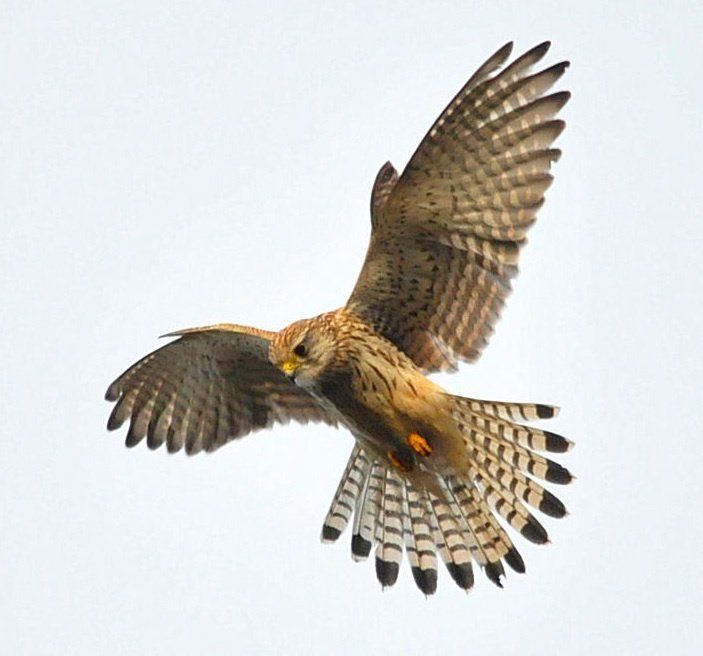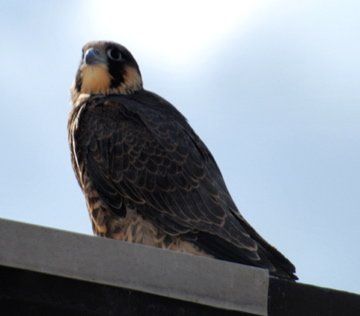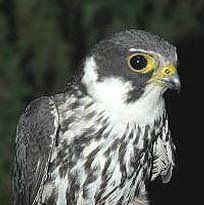- Home
- General Information
- Sightings
- Birding Locations
- Publications
-
Archive 1987 - 2018
- A Checklist of Bradford's Birds
- Swans & Geese
- Ducks & Sawbills
- Divers, Grebes, Herons
- Eagles, Kites & Harriers
- Buzzards & Hawks
- Falcons
- Grouse, Quail, Crakes
- Waders - Part1
- Waders - Part 2
- Skuas and Gulls
- Terns & Auks
- Doves, Nightjar & Alpine Swift
- Hoopoe, Wryneck, Larks, Pipits
- Owls, Woodpeckers
- Thrushes
- Warblers and Tits
- Shrikes and Crows
- Sparrows, Buntings and Finches
- Gallery
Falcons
KESTREL
Falco tinnunculus
Common resident breeder/passage migrant. History of Kestrel in Bradford Ornithological Group area 2009 - 2018
2015
- The 243 records are only two-thirds of those received during the previous year. This is most certainly due to the reasons given in the
In 2014, 25% of the Kestrel records came from Barden Scale, but this year there were just six!
Many records included details of pairs hunting together, courtship activity and family groups ranging over rough grassland. At Bradup, Glovershaw, Keighley Moor, Barden Fell and Timble Ings birds involved in activities of this sort were seen in spring; and in late summer juveniles and adults were witnessed interacting. This was particularly well- documented at Warley Moor Reservoir where double-figure counts were registered on five occasions during this summer period.
At three sites in Wharfedale, ten chicks were ringed and a box at Thruscross, thought to have been abandoned, contained four eggs. In the Washburn Valley, ten broods produced a total of 41 juveniles (PRo, CoH).
2016
- Whilst some 200 records are reasonable (though 20% down on last year, and nearly 50% down on 2014), there were scarcely any reports of pre-breeding activity, far fewer breeding successes, and, in general, smaller numbers of birds were seen. This was almost certainly due, as mentioned by one observer, to it being a poor vole year, following a very wet winter.
Twos and threes were generally the best on offer, and only a family party of four at Slippery Ford, the same number relocating at Caldene Fields, and five seen at Esholt broke this pattern. As for breeding, even the work of the regular ringer in Wharfedale and the Washburn was less rewarded, as this year’s total of 12 young compares with last year’s 51. The only other breeding successes recorded was of two young raised at both Slippery Ford and Salts Mill, but a very young bird seen at Addingham had presumably local origins, though the birds occupying a box at Stockbridge weren’t reported to have succeeded.
2017
- Clearly abundant, though the only significant count was of 11 birds near Warley Moor Reservoir in August. An improved breeding picture, involving at least 31 young, although it is now clear the 2016 total may have been much understated. Most records came from the Washburn, with a few in Wharfedale and Airedale.
2018
- The 259 records indicate the species’ abundance throughout, but the only notable counts were up to eight at Warley Moor Reservoir in October. These were considered to be a post-breeding party, but the only specific data came from the Washburn and Denton, where 24 young were raised.
RED-FOOTED FALCONAquila chrysaetos
1992
A second-summer male spent six days near Scargill Reservoir. The bird was observed at Hunter’s Stones on 29th May and Sandwith Moor on the following day.
2010
A female watched taking insects at Bolton Abbey on 11th June is only the second Group record, following one in 1992.
HOBBY
Falco subbuteo
Uncommon, but regular summer visitor/passage migrant.
2015 - With just 13 records, this was an average year though for reasons mentioned in the Editorial, there may well have been more. Upper Wharfedale has long been an area much favoured by this superb raptor. There was strong evidence of breeding there in 2013, and activity noted this year was again suggestive of this. Two birds were often seen on these fells in June and July, with prey being carried by one of the pair (BV, KM, MD, PD&JBP). A similar situation occurred in the south of the area, where several sightings of adults were followed in July with views of juveniles (IH). An individual moved south at Bramley Head in late August (KM), and in September singles were in Upper Wharfedale (BV) and over Oxenhope Watchpoint (DB, HC).
2016 - With only six records, this was a well below average year, and, surprisingly, there were no reports from Upper Wharfedale. Spring sightings were of single birds near Yeadon Tarn on 1st June (MB), and the Lower Washburn Valley on the 10th (AJ) and 16th (PRo). Six weeks later on individual was noted at Slippery Ford, on 27th July (IH), and the remaining reports were of birds in August, at Timble Ings on the 5th (WNS), Keighley Moor Reservoir on the 18th (IH), and at Otley Wetland on the 29th, where a bird pursued Swallows round a mist-net (WNS).
2017
- Eighteen records, fairly well-distributed, is a reasonable return. Barden Scale produced singles on six days between 13th May and 19th August (BV), and elsewhere in Wharfedale individuals were at Otley Wetland on three days in July and August (AJ). Elsewhere, there were singles on Keighley Moor in June (IH), at Esholt in July (AJ), Leeshaw and Menston in August (BV, WNS), and two sub-adults on Sandwith Moor on the late date of 11th October (AJ). Other late sightings were passage birds at Oxenhope Watchpoint on four dates between 20th September and 8th October (DCB, HC).
2018
- A total of eight birds is down on recent years. Most of the reports were from north of the Aire and in June, when birds were seen at Barden on 4th and 13th (HC, BV), Timble on 6th (AJ), and near Hawksworth on 17th (RW). Birds were noted over Pool on 19th July and 3rd August, and on the 1st a bird picked up at Arthington was released at Otley Wetland (AJ). Also in August, there was a further Barden record on the 21st (BV). The sole Airedale record came from Slippery Ford on 13th June (IH).
PEREGRINE
Falco peregrinus
Resident and occasional breeder; passage/winter visitor. History of Peregrine in Bradford Ornithological area 2009 - 2018
2015
- Once more, most of the 40 records submitted were of birds seen in the Aire Valley, particularly in Bradford and Keighley. As in 2014, an adult male was seen on a Bradford chimney throughout January and March. However, after two males, one believed to be a young adult, were seen in the area on 15th March, there were no further reports until 10th October when an adult male was again seen (JL, KM). The situation in Keighley was much more successful, as breeding took place at the site previously used and two juveniles were seen with parents in June (MS).
On Keighley Moor, during August, a large female was watched as it mobbed a couple of Common Buzzards before a passing Hobby joined the fray. In the middle of the month a juvenile was seen to chase a pigeon, which evaded capture by dropping into the heather. The raptor looked in vain for its prey before taking off and then it was seen to unsuccessfully chase a juvenile Kestrel (IH).
There were also reports from Stockbridge, Bradup, Leeshaw and Bingley during the summer months, some of which may have been associated with the Keighley breeding pair (SR, RP, PM et al). Birds were also seen to the south of the valley at Warley Moor Reservoir, Denholme Clough, Haworth Moor and from the watchpoints at Caldene Fields and Oxenhope (MD, KM, CB). In the north of the area a bird was on Hazlewood Moor on 19th August and another was to the west of here on Barden Fell at the end of November (RN, WNS).
2016
- The 42 records received are much in line with 2015, but well down on many past years. A sign of changing times is that nearly 90% of the reports came from the south of the area: a complete reversal of the picture 20 years ago. Only a handful of sightings from Otley Wetland and Barden Fell upset this near-monopoly.
There having been several years with good breeding successes, the cupboard this year seems bare, though there were tantalising reports of birds at previously established sites. A pair was seen on the Keighley chimney used in earlier years, but not after mid-February, and they were also present at another long-used site up to the middle of the year at least, but at neither did they appear to breed. No birds were seen on the Bradford chimney where there have been sightings in the past, but a male was seen soaring and displaying in the general area in early April. More intriguing was a record of a pair soaring over moorland on 16th May (which the observer considered might be failed breeders), to be followed by a record of a juvenile male on the same moor three weeks later. However, a colour-ringed juvenile here in late August was believed to have originated from Lancashire.
2017
- Better-reported than last year, and, as in other recent years, most records are from the south of the area, and there continue to be several from the suburbs and even town centres. Most records were of singles or pairs, but four birds were seen at Barden and Oxenhope Moor. The only definite breeding record was from Keighley, where birds returned to the previously used site and three juveniles were watched. A bird was also seen at a previous breeding location.
2018
- As in 2017, there were 95 records, and again most came from the south, and included several urban reports. Single birds were the norm, though two were seen on a few occasions, and exceptionally three at Barden in January, and six in total passing Oxenhope Watchpoint. The well-established Keighley site was again in use, and three young were raised. No other successes were reported, though a pair visited a previously used site in May, and there were several sightings at what has been considered a potential breeding location in Bradford.
MERLIN
Falco columbarius
Uncommon resident breeder and passage migrant. History of Merlin in Bradford Ornithological area 2009 - 2018
2015
- There were 33 reports from five main locations on the moorland fells. Although breeding was only confirmed at one nest, where five hatched eggs produced four young males and a female, there was plenty of evidence to suggest that there was more of this activity at other sites. Pairs were seen in spring defending their territory and chasing Meadow Pipits.
At one location symbiotic hunting involved a female bird trailing ten metres behind a Marsh Harrier and taking advantage of those passerines flushed by the bigger bird. Nearby there were persistent calls from a female or juveniles whenever the male was hunting (IH). In June and July an adult female was seen with a juvenile (PD&JBP) at one of the main sites. At another location adults and juveniles mobbed a Red Kite and others were keen to chase off a Hen Harrier. Reports also suggested that the mild conditions towards the end of the year had encouraged Meadow Pipits, and subsequently Merlins, to remain on the moor. Records of these birds late in the year are unusual, but a female on 20th November and another watched at close range on 8th December are symptomatic of the changes affecting our climate.
A total of seven birds passed the watchpoint at Oxenhope during September and October.
2016
- For the first time in many years, not only were there no specific breeding reports, but there were only two records of display flight from different moorland areas, though a juvenile seen at one of them on 16th August was perhaps suggestive of local breeding. This particular bird seemed to be less savvy than the young Pied Wagtail it was chasing, which seemed to use the observers as protection, by diving into cover right next to them, causing the falcon to veer away.
Reports from three other moors were generally just of single adults, but an adult and possible juvenile were seen together on one occasion. A total of 10 birds passing Oxenhope Watchpoint between 28th August and 3rd November were clearly transient, and took advantage of the ready supply of passerines moving at the same time.
2017
- Apart from six birds on migration at Oxenhope, and a solitary moorland breeding record, all other sightings involved singles, mainly at moorland sites across the area.
2018
- A reasonable number of records came mainly from moorland sites, and the majority in the south. Though singles again predominated, two birds were seen on several occasions, at Hazlewood Moor and Ovenden Moor, and nine in total migrated past Oxenhope Watchpoint. The Ovenden birds may have been a breeding pair, and this certainly took place on Keighley Moor.



